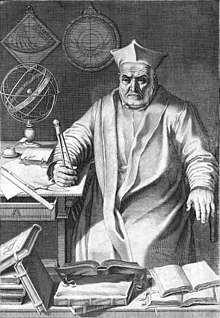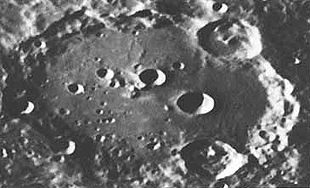Christophorus Clavius
Christophorus Clavius (born March 25, 1538 , possibly as Christoph Clau or key in or near Bamberg , † February 6, 1612 in Rome ) was a mathematician and Jesuit priest at the Collegio Romano . Called "Euclid of the 16th century" by his contemporaries , he became famous above all for the calendar reform to the Gregorian calendar that was carried out under his professional direction , which was introduced in 1582 with the Bull Inter gravissimas by Pope Gregory XIII. was decreed. Clavius implemented a reform draft by Aloisius Lilius , who had died in 1576.

Life
Only the Latinized form of the name of Clavius from Bamberg is known. In 1555 he joined the Jesuit order and received his education there. Certainly attracted by the reputation of Pedro da Fonseca , who was also known as the "Portuguese Aristotle", Clavius came to the University of Coimbra in Portugal , where Pedro Nunes was his teacher. He later studied theology at the Collegio Romano in Rome and taught mathematics there throughout his life. Clavius wrote several mathematics books, including a commentary on Euclid (1574) and on the most important astronomical textbook of the late Middle Ages, the Sphaera of Johannes de Sacrobosco . In 1608 he wrote a textbook on algebra . His works were reprinted several times even after his death, his annotated translation of Euclid's Elements up to 1717.
He was the founder of the scientific work at the Vatican Observatory and also designed astronomical instruments such as sundials. For this purpose, Clavius described in his Fabrica et usus instrumenti ad horologiorum descriptionem peropportuna of 1586 a ruler to mark the lines on the sundials. Clavius and his students at the Collegio Romano maintained friendly relations with Galileo Galilei and corresponded with him about new discoveries with the telescope; The Roman Jesuits discovered the phase form of Venus independently of Galileo and perhaps even before him. The first Jesuit missionary to China , Matteo Ricci , also emerged from Clavius' school .
According to an unconfirmed narrative, Clavius is said to have been killed by a wild ox on a street near Rome in 1612 while visiting the seven churches of Rome . In the monthly correspondence for the promotion of geography and celestial science from October 1813, however, this version of Clavius' end of life was rejected as false and unfounded. The news may come from a misunderstood poem written in honor of Clavius after his death. It says: "The sun went down in Taurus and was darkened." None of the other historians reported anything of this spectacular death. Rather, on January 1, 1612, Clavius reported to the Bamberg prince-bishop Johann Gottfried von Aschhausen that his old age and the associated complaints tied him to bed. This makes it unlikely that he would have visited the seven churches of Rome in his poor condition.
Existing services
Gregorian calendar reform
The Gregorian calendar reform was essentially designed and implemented by him on the basis of the suggestions made by Aloisius Lilius , who died in 1576 . It is still valid today. October 4, 1582 was followed by October 15. All years divisible by four are leap years (except for those that end in "00", they are only leap years if they are divisible by 400). The reform met with some fierce resistance (it was only implemented much later in the Protestant and Orthodox countries) and was scientifically defended by him. In addition, he published the two writings Novi calendarii Romani apologia (Rome, 1588) and Romani calendarii a Gregorio XIII restituti explicatio (Rome, 1603).
Decimal point
In 1593, Clavius used a point as a decimal separator between the integer part and the tenth in the sine tables of his astrolabe . According to Carl Boyer , this made him the first person to use the decimal point with a clear idea of its meaning. As far as we know today, Francesco Pellos came before him in 1492, but his works did not come close to spreading like Clavius.
Commemoration
- The lunar crater Clavius reminds of him. The asteroid (20237) Clavius was named after him .
- The Clavius-Gymnasium in Bamberg is named after him.
- In Bamberg, at the University 2, the former Jesuit college, there is a memorial plaque.
- Claviusstrasse exists in Bamberg.
- Clavius made a brief appearance in Bertolt Brecht's play The Life of Galileo
Individual evidence
- ↑ Lattis, Christopher Clavius, Dictionary of Scientific Biography
- ↑ Ralf Kern: Scientific instruments in their time. , Volume 2: From Compendium to Individual Instrument. , Cologne 2010, Walther König Verlag, ISBN 978-3865608666 . P. 255.
Fonts
- Novi calendarii romani apologia , Rome 1588
-
Romani calendarii a Gregorio XIII PM restituti explicatio . Rome, 1603
- Romani calendarii a Gregorio XIII PM restituti explicatio . (European Cultural Heritage Online)
- Romani calendarii a Gregorio XIII PM restituti explicatio . ( University of Notre Dame )
-
Euclides Elementorum Libri XV , Rome 1574
- Front page, MAA
- Elementorum Libri XV . Cologne, 1627 (Saxon State Library - Dresden State and University Library)
- Gnomonices , 1581 (about the Gnomon )
- Algebra 1608
- Geometria practica , 1606
- Refutatio cyclometriae Iosephi Scaligeri . Mainz, 1609
- Christoph Clavius: Corrispondenza Edizione critica a cura di Ugo Baldini e Pier Daniele Napolitani . Università di Pisa - Dipartimento di Matematica, Pisa 1992. (Critical edition of the correspondence)
- Collected works, 5 volumes, Mainz 1612: Online .
- More books by Clavius at the MPI History of Science Berlin
literature
- Romano Gatto: Clavio, Cristoforo . In: Il contributo italiano alla storia del pensiero. Scienze , Treccani, Rome 2013
- Ugo Baldini (Ed.): Christoph Clavius el 'attività scientifica dei gesuiti nell' età di Galileo. Atti del Convegno Internazionale (Chieti, April 28-30, 1993) . Bulzoni editore, Rome 1995.
- James M. Lattis: Between Copernicus and Galileo. Christoph Clavius and the collapse of Ptolemaic cosmology. University of Chicago Press, Chicago IL et al. 1994, ISBN 0-226-46927-1 .
- Otto Meyer: Christoph Clavius . In: Franconian pictures of life . New series of CVs from Franconia. Bd. 8, Kommissionsverlag Degener, Neustadt / Aisch 1978, ISBN 3-7686-9046-6 , pp. 80-92.
- James Lattis: Christopher Clavius , Complete Dictionary of Scientific Biography , Online
- HLL Busard: Clavius, Christoph . In: Charles Coulston Gillispie (Ed.): Dictionary of Scientific Biography . tape 3 : Pierre Cabanis - Heinrich von Dechen . Charles Scribner's Sons, New York 1971, p. 311-312 .
- Edmondo Lamalle: Clavius, Christoph. In: New German Biography (NDB). Volume 3, Duncker & Humblot, Berlin 1957, ISBN 3-428-00184-2 , p. 279 ( digitized version ).
- Karl Christian Bruhns : Clavius, Christoph . In: Allgemeine Deutsche Biographie (ADB). Volume 4, Duncker & Humblot, Leipzig 1876, p. 298 f.
- Cristoforo Clavio in the archives of the Pontifical Gregorian University
Web links
- Literature by and about Christophorus Clavius in the catalog of the German National Library
- Works by and about Christophorus Clavius in the German Digital Library
- Catholic Encyclopedia 1917 (English)
- John J. O'Connor, Edmund F. Robertson : Christophorus Clavius. In: MacTutor History of Mathematics archive .
- The Galileo Project - biography of Christopher Clavius.
- Opera Mathematica - the complete mathematical works of Christopher Clavius.
- Clavius, Christoph; Baldini, Ugo; Napolitani, Pier Daniele (eds.), Corrispondenza , 1992 (1.15 GB) Critical edition of the extant Clavius' correspondence.
- Spektrum.de: Christopher Clavius (1538–1612) February 1, 2014
Original works:
- Geometria Practica . Moguntiae 1606, online edition of the Saxon State Library - State and University Library Dresden
- Christophori Clavii Bambergensis E Societate Iesu Epitome Arithmeticae Practicae . Coloniae Agrippinae 1607, online edition of the Saxon State Library - State and University Library Dresden
- Refutatio Cyclometriae Iosephi Scaligeri . Moguntiae 1609, online edition of the Saxon State Library - Dresden State and University Library
- Elementorum Libri XV . Coloniae 1627, online edition of the Saxon State Library - Dresden State and University Library
- Romani Calendarii A Gregorio XIII. PM restituti explicatio . Romae 1603, online edition of the European Cultural Heritage Online
| personal data | |
|---|---|
| SURNAME | Clavius, Christophorus |
| ALTERNATIVE NAMES | Clau, Christoph; Key, Christoph |
| BRIEF DESCRIPTION | German mathematician and Jesuit priest |
| DATE OF BIRTH | March 25, 1538 |
| PLACE OF BIRTH | Bamberg |
| DATE OF DEATH | February 6, 1612 |
| Place of death | Rome |


